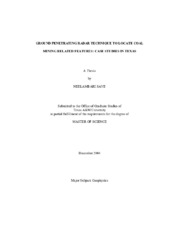| dc.description.abstract | The goal of this research project is to identify the efficacy of the ground
penetrating radar (GPR) technique in locating underground coal mine related subsidence
features at Malakoff and Bastrop, Texas. The work at Malakoff has been done in
collaboration with the Railroad Commission of Texas (RRC). RRC has been carrying
out reclamation of abandoned underground coal mines at Malakoff since the early
1990Â’s. The history of the specific mining operations (at Malakoff and Bastrop) that
took place in the early 1900Â’s has been difficult to ascertain; therefore, the use of a
geophysical techniques like ground penetrating radar to identify hidden voids and
potential subsidence features is vital for future reclamation process. Some of the
underground mine workings at the field site have collapsed over time affecting the
topography by creating sinkholes. GPR data, employing 25 MHz, 50 MHz and 100
MHz frequency antennae, have been collected in common offset patterns and azimuthal
pattern. GPR data indicate the mine tunnels possibly connecting existing sinkholes by
radargram hyperbolae that correspond with mine openings observed visually or during
reclamation. This study also denotes the importance of understanding the variable
physical properties of the stratigraphy, which could lead to false alarms by
misinterpretation of the radar signals. Natural and man-made above-ground structures
cause obstructions in data collection, and hence an optimal design is required for each
survey. RRC successfully ground-truthed the data during its reclamation process. In
turn, the acquired geophysical data helped to guide the reclamation. At Bastrop, GPR
data along with historical documentation led to the conclusion that coal mining did exist
in this region but is not a major concern to the immediate stability and safety of the field
site. It can be concluded from both the studies that the GPR technique identifies
anomalous shafts/tunnels possibly connecting potential failure. | en |


